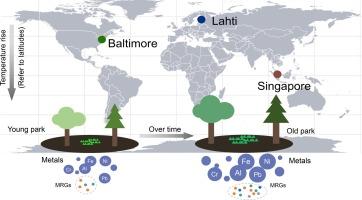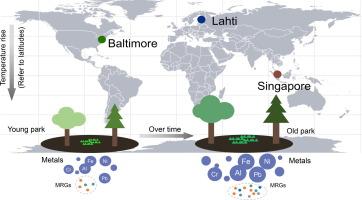是什么驱动了城市公园土壤中的金属抗性基因?公园的年龄关系到各个生物群系
IF 9.7
1区 环境科学与生态学
Q1 ENVIRONMENTAL SCIENCES
引用次数: 0
摘要
尽管抗性基因在生态系统中是一个全球性的问题,但导致其在全球范围内传播的潜在因素,特别是在城市绿地中,却鲜为人知。为了研究城市公园中金属和金属抗性基因(MRGs)的积累,我们利用ICP-MS分析了金属浓度,并利用GeoChip功能基因阵列分析了城市公园和非城市参考点中具有不稳定凋落物和抗性凋落物的植被类型中MRGs的丰度。这些植被类型包括三个不同的气候区:北方气候区(芬兰)、温带气候区(美国巴尔的摩)和热带气候区(新加坡)。结果表明,各气候带公园土壤中金属浓度和MRGs丰度随着公园年龄的增加而增加,特别是优势金属-铁和铝-占总金属含量的90%以上,以及其他金属,如Mn, Zn和Pb。相应的,铁和铝耐药基因是最丰富的mrg,占所有检测到的mrg的23%。植被类型仅在寒带地区对金属和MRGs有影响,而在温带或热带地区没有影响,这表明植被背景不能在不同气候带中推广。我们的分析还表明,抗性基因的分布仅受土壤性质的微弱影响,而主要与交通和工业来源的金属积累有关。我们的数据进一步表明MRGs和抗生素耐药基因(ARGs)是通过金属积累共同选择的。老公园和年轻公园之间的MRG丰度格局与arg相似,表明城市老公园对人类健康存在潜在风险。我们的研究结果强调了公园年龄和相应的人为活动累积效应作为全球城市土壤中金属和MRG动态驱动因素的重要性。本文章由计算机程序翻译,如有差异,请以英文原文为准。


What drives metal resistance genes in urban park soils? Park age matters across biomes
Although resistance genes are a global concern in ecosystems, the underlying factors responsible for their worldwide dissemination, especially in urban greenspaces, are poorly known. To investigate metal and metal resistance genes (MRGs) accumulation in urban parks, we used ICP-MS to analyze metal concentrations and GeoChip functional gene arrays to analyze MRGs abundances in vegetation types with labile and recalcitrant litter across urban parks and non-urban reference sites in three distinct climatic regions: Boreal (Finland), Temperate (Baltimore, USA), and Tropical (Singapore). Our results indicate that metal concentrations and MRGs abundances in park soils increase with park age across climatic zones, especially so for the dominant metals − Fe and Al − accounting for more than 90% of the total metal content, and others, e.g., Mn, Zn, and Pb. Correspondingly, Fe and Al resistance genes were the most abundant MRGs, representing 23% of all detected MRGs. Vegetation type affected metals and MRGs only in the boreal region, not in temperate or tropical regions, suggesting that vegetation context is not generalizable across climatic zones. Our analyses also indicate that the distribution of resistance genes is only weakly affected by soil properties, but largely associated with accumulation of metals from traffic and industrial sources. Our data further indicate that MRGs and antibiotic resistance genes (ARGs) are co-selected by metal accumulation. The pattern of MRG abundance between old and young parks is similar to that of ARGs, indicating a potential risk for human health in old urban parks. Our findings emphasize the importance of park age and the corresponding cumulative effects of anthropogenic activities as a driver of metal and MRG dynamics in urban soils globally.
求助全文
通过发布文献求助,成功后即可免费获取论文全文。
去求助
来源期刊

Environment International
环境科学-环境科学
CiteScore
21.90
自引率
3.40%
发文量
734
审稿时长
2.8 months
期刊介绍:
Environmental Health publishes manuscripts focusing on critical aspects of environmental and occupational medicine, including studies in toxicology and epidemiology, to illuminate the human health implications of exposure to environmental hazards. The journal adopts an open-access model and practices open peer review.
It caters to scientists and practitioners across all environmental science domains, directly or indirectly impacting human health and well-being. With a commitment to enhancing the prevention of environmentally-related health risks, Environmental Health serves as a public health journal for the community and scientists engaged in matters of public health significance concerning the environment.
 求助内容:
求助内容: 应助结果提醒方式:
应助结果提醒方式:


